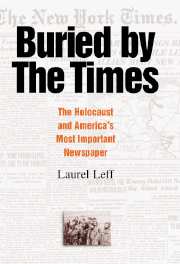Book contents
- Frontmatter
- Dedication
- Contents
- Acknowledgments
- Note Abbreviations
- Introduction: “Last Voice from the Abyss”
- PART I 1933—1941
- PART II 1942—1945
- 5 “To Awaken the Conscience of Christendom”: Pressure to Publicize the First News of the Extermination Campaign
- 6 “Amidst the Advertisements on Page 19”: Placement Decisions and the Role of the News Editors
- 7 “All Jews Are Not Brothers”: The Publisher's Fight with Zionists
- 8 “The Semitic Question Should Be Avoided”: German Atrocities and U.S. Government Propaganda
- 9 “Final Phase of Supreme Tragedy Has Begun”: The War Refugee Board and the Destruction of Hungary's Jews
- 10 “Political Prisoners, Slave Laborers, and Civilians of Many Nationalities”: The Liberation of the Concentration Camps
- 11 “Lessons from the Hitler Tragedy”: The Publisher and the Aftermath of War
- Conclusion: “The Horrible Story Was Not Told”
- Appendix A Key Individuals
- Appendix B Key Institutions
- Appendix C List of Front-Page Stories
- Notes
- Index
7 - “All Jews Are Not Brothers”: The Publisher's Fight with Zionists
Published online by Cambridge University Press: 05 February 2015
- Frontmatter
- Dedication
- Contents
- Acknowledgments
- Note Abbreviations
- Introduction: “Last Voice from the Abyss”
- PART I 1933—1941
- PART II 1942—1945
- 5 “To Awaken the Conscience of Christendom”: Pressure to Publicize the First News of the Extermination Campaign
- 6 “Amidst the Advertisements on Page 19”: Placement Decisions and the Role of the News Editors
- 7 “All Jews Are Not Brothers”: The Publisher's Fight with Zionists
- 8 “The Semitic Question Should Be Avoided”: German Atrocities and U.S. Government Propaganda
- 9 “Final Phase of Supreme Tragedy Has Begun”: The War Refugee Board and the Destruction of Hungary's Jews
- 10 “Political Prisoners, Slave Laborers, and Civilians of Many Nationalities”: The Liberation of the Concentration Camps
- 11 “Lessons from the Hitler Tragedy”: The Publisher and the Aftermath of War
- Conclusion: “The Horrible Story Was Not Told”
- Appendix A Key Individuals
- Appendix B Key Institutions
- Appendix C List of Front-Page Stories
- Notes
- Index
Summary
During 1942, as the Times published accounts of the millions already dead in Eastern Europe and the millions more in imminent danger, Arthur Sulzberger issued a written order to his staff about how to handle the unfolding events. A five-paragraph story on a speech by William Green, American Federation of Labor president, condemning “the slaughter of hundreds of thousands of Jews in Europe by the Nazi butchers,” caught Sulzberger's attention. But it was not the condemnation or who was issuing it that interested Sulzberger. “I have been trying to instruct the people around here on the subject of the word ‘Jews’, i.e., that they are neither a race nor a people, etc.,” Sulzberger wrote to his Washington Bureau Chief Arthur Krock at the end of December. The person who wrote the story's main headline (“A.F.L. Head Condemns Nazi Killing of Jews”) “had learned his lesson,” Sulzberger wrote. So had Green, who referred to “Jews.” “But the fellow in the Washington Bureau who wrote the lead turned what Green said into ‘the Jewish people.’ Will you caution him?” Krock did, asking his deputy to “please issue the necessary instructions.”
For Sulzberger, the drive against Jewish nationalism – against conceiving of Jews as a people, against a Jewish homeland in Palestine, against the leaders who advocated those stances – overshadowed every other issue, even Hitler's plan to make Jewish nationalism an irrelevancy.
- Type
- Chapter
- Information
- Buried by the TimesThe Holocaust and America's Most Important Newspaper, pp. 192 - 235Publisher: Cambridge University PressPrint publication year: 2005



